ODA Topics 03
Report of the Third UN World Conference on Disaster Risk Reduction
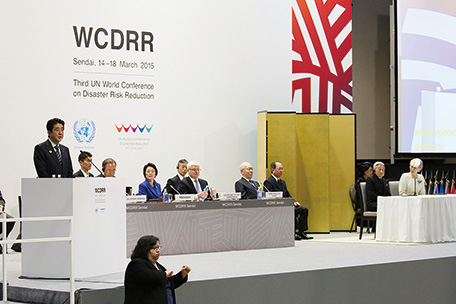
Opening ceremony of the UN World Conference on Disaster Risk Reduction. (Photo: Cabinet Public Relations Office)
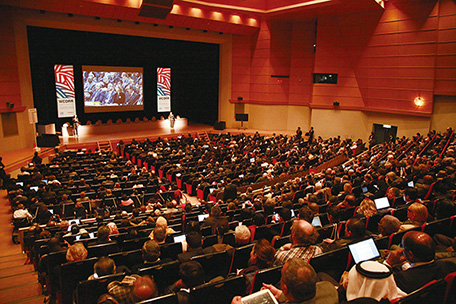
The venue of the Third UN World Conference on Disaster Risk Reduction. (Photo: UNISDR)
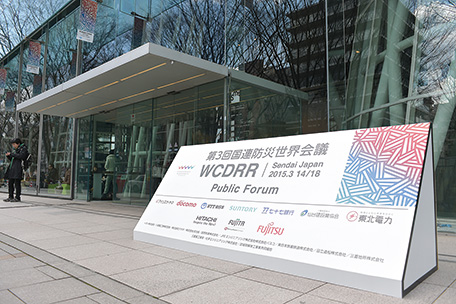
The entrance to the Public Forum of the Third UN World Conference on Disaster Risk Reduction. (Photo: UNISDR)
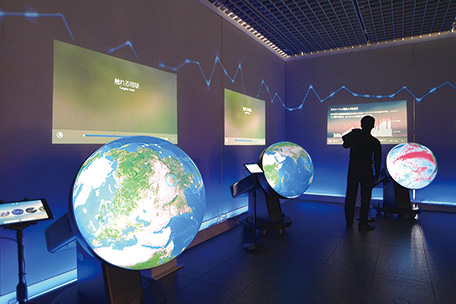
The special exhibition “Tangible Earth Museum.” (Photo: UNISDR)
The Third UN World Conference on Disaster Risk Reduction was held in Sendai City from March 14 to 18, 2015.
Participants in this UN-hosted conference discussed international strategy on disaster risk reduction. As a country that is proactively engaged in efforts to promote international cooperation for disaster risk reduction, taking advantage of its extensive knowledge and experience in this field, Japan hosted the third conference, following the first conference in Yokohama in 1994 and second conference in Hyogo (Kobe) in 2005. In this conference, 185 United Nations member states participated and more than 6,500 persons including heads of state of seven countries, vice-president-level officials from six countries, deputy prime ministers from seven countries, and ministerial-level officials from 84 countries also participated. A total of 150,000 people from both Japan and abroad participated in the conference and the related events to make this the largest-ever international conference held in Japan.
On the occasion of the conference, three High Level Multi-stakeholder Partnership Dialogues took place on the following themes: “Mobilizing women’s leadership in disaster risk reduction,” “Risk sensitive investment,” and “Inclusive disaster risk reduction.” In the session “Mobilizing women’s leadership in disaster risk reduction,” Prime Minister Shinzo Abe delivered a keynote speech, in which he stated the important role played by women in disaster risk reduction on the basis of the experience in the Great East Japan Earthquake. In addition, during the conference, five ministerial roundtable sessions and more than 350 symposiums and seminars were held, in which a diverse range of stakeholders on various levels engaged in the issue of disaster risk reduction from a broad range of perspectives. Overall, the conference provided a valuable opportunity to deepen and expand the understanding of the international community on the issue of disaster risk reduction.
In hosting the conference, Japan had three major goals. The first goal was to introduce the perspective of disaster risk reduction in the planning and implementation of various policies (“mainstreaming of disaster risk reduction”). The second goal was to transmit Japan’s knowledge and technology concerning disaster risk reduction, and the third goal was to provide information regarding the reconstruction from the Great East Japan Earthquake and to contribute to the recovery of the disaster-affected areas.
Significant results were attained with regard to the mainstreaming of disaster risk reduction. The conference adopted the “Sendai Framework for Disaster Risk Reduction 2015-2030,” which succeeds the “Hyogo Framework for Action,” the international guiding principle for disaster risk reduction adopted at the Second UN World Conference on Disaster Risk Reduction. In the new international guiding principle for disaster risk reduction, many ideas suggested by Japan such as the importance of investment in disaster risk reduction, commitment by various stakeholders, promotion of women’s and young people’s leadership, and the concept of “Build Back Better” were included. The perspective of disaster risk reduction was also incorporated in the “2030 Agenda for Sustainable Development” adopted in September 2015.
Furthermore, Prime Minister Abe announced the “Sendai Cooperation Initiative for Disaster Risk Reduction” as Japan’s new contribution plan. This initiative will become Japan’s future basic policy for cooperation in the field of disaster risk reduction. The initiative positions disasters as obstacles to poverty eradication and sustainable development, and as threats to human security, and highlights the importance of the concept of mainstreaming of disaster risk reduction, where governments introduce the perspective of disaster risk reduction in all development policy and planning.
Additionally, as part of the “Sendai Cooperation Initiative for Disaster Risk Reduction,” Japan announced that in the four years from 2015 to 2018, it will provide 4 billion US dollars in total to the area related to disaster risk reduction and train 40,000 officials to play a leading role in national efforts for disaster risk reduction and post-disaster reconstruction. This announcement demonstrated Japan’s attitude to further contribute to the international community through utilization of its advanced knowledge and technology in the field of disaster risk reduction. Such contribution was highly appreciated by the international community. For example, Mr. Ban Ki-moon, Secretary-General of the United Nations, stated in his press conference that Japan’s assistance is a model for other developed countries.
The fact that the Third UN World Conference on Disaster Risk Reduction was held in Sendai, one of the areas affected by the Great East Japan Earthquake, was also of great significance. With cooperation from the surrounding local governments, the conference provided an opportunity to showcase the reconstruction after the Great East Japan Earthquake. Specifically, food and liquors produced in the disaster-affected areas were actively provided in the lunch and dinner meetings hosted by Prime Minister Abe and Foreign Minister Fumio Kishida and at the receptions hosted by the Government of Japan and Sendai City to counter harmful rumors and to contribute to the reconstruction of disaster-affected areas. Moreover, it became possible to convey the current condition and reconstruction status of the disaster-affected areas through study tours carried out by each local government in the vicinity of Sendai City.
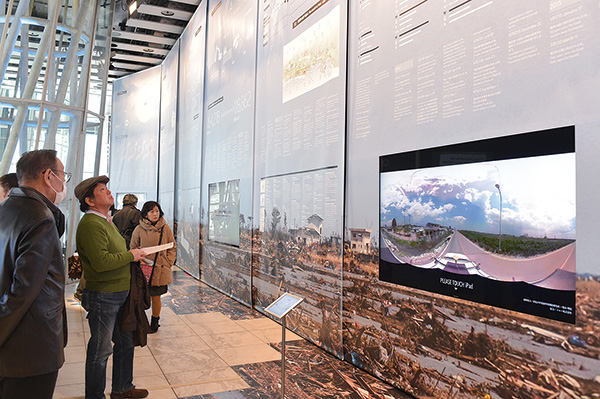
Visitors observe intently the public exhibitions at the Third UN World Conference on Disaster Risk Reduction. (Photo: UNISDR)
